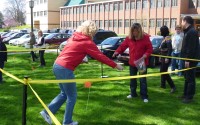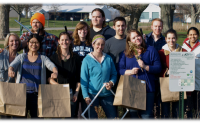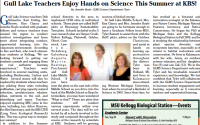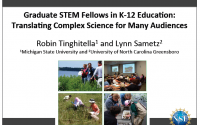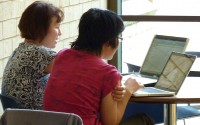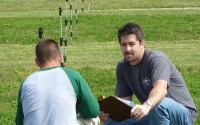Tyler just finished up the first of his two years as a GK-12 Fellow. This year, he’s been working in Gull Lake Middle School with two teachers, Kim Clancy and Jennifer Boyle. Read up on some of his work, including work on our BEST plots research network, on page 7 of the district’s newsletter (below). This is the second time Tyler made the news in the Gull Lake Communicator- they must really like him over there!
Plainwell AP Biology Students Take Their Show on the Road with GK-12 Fellow Tomomi Suwa
Fellow Tomomi Suwa and Sandy Breitenbach’s AP Biology Students recently travelled to Grand Valley State University to present their 2011-2012 research projects. Here’s the scoop from Tomomi… April 25th was a big science day for 14 students from Plainwell high school. They each presented a poster on their independent project at the Michigan High School Math and Science Symposium at Grand Valley State University. Among 40 other presenters from Southwest Michigan schools, the students from Plainwell represented their school very well. These students are from Mrs. Sandy Breiteinbach’s AP Biology class and since last September, I’ve been working closely with them to go through the entire process of science including picking interesting questions, designing an experiment and analyzing the data. They each came up with creative projects such as the effects of spotted knapweed on native plant species, differences in […]
Evolving to Invade – How can evolution by natural selection create invasive species?
Many invasive species do not start to invade as soon as they are introduced into a new area; there is a “lag time” in most invasions where scientists predict they are evolving to their new habitat and waiting for beneficial genes to arrive, either through mutation or further introductions of new individuals from their native range. Through an interactive game, students will learn how evolution might create an invasive species. The game demonstrates the basic components of evolution (variation and selection) and how they can cause an introduced species to become invasive and out-compete native species. At the conclusion of the lesson, students will be able to understand the basic concepts of evolution and biological invasions including: Evolution by natural selection Three factors required for evolution by natural selection to occur (variation in trait, fitness differences, inheritance) Source of variation […]
Our April 11th Workshop Update
By Guest Blogger and KBS GK-12 Friend Joelyn de Lima April 11, 2012 was a day loaded with fun at KBS. Our GK-12 Fellows outdid themselves developing interesting and informative lessons and games that addressed the topic for the day “Evolution and the Biodiversity of Life” from different viewpoints. Topics ranged from the evolution of beak shape to mimicry and invasiveness. The day began with Tom Getty giving a brief update we call “The State of the BEST Plots”. Most of our plots are in a good shape, but a few had to be visited by the Round-Up fairy! The speaker of the day, Jenny Boughman, took over from Tom and spoke on the topic “The Evolution of Complex Adaptations: The Eyes Have It!”. She talked about how evolution works by taking existing structures and changing them bit-by-bit. Since eyes […]
Fertilization Protocol
Here you will find the protocol for fertilizing the GK-12 BEST fertilization treatment plots. We want to test hypotheses about how fertilization influences plant productivity and diversity and how fertilization treatment effects might relate to soil properties and to invertebrate abundance and diversity on the plots. Each block has 8 plots, 4 of which will receive fertilization. Fertilization begins in year two after establishment (Spring 2012). Fertilization Protocol
The BEST Team represents us at the 2012 GK-12 Annual Meeting in Washington DC
Report from Tom: Nick, Marcia, Alycia, Tomomi, Robin and Liz presented and represented our GK-12 Project at the 2012 Annual Meeting for GK-12 Project Teams, held at the Hyatt Regency on Capitol Hill, March 16-18. I cheered them on, took pictures and took great pride in they way they represented all of us. Nick’s roundtable discussions about fostering quantitative reasoning skills were well-attended and well-received. Our BEST Team presentation on Building Long-Term Research Projects and Collaborations was a big hit, even though it was at the worst possible time (early Sunday morning) and location (a room hidden behind the bar). Participants were very enthusiastic about our presentation and activities and full of questions and suggestions. It was especially gratifying to learn that other projects are studying our website and adopting some of our innovations. There were 103 projects represented at […]
Climate Change: the basis of belief
In this lesson, students will examine three claims made about global warming: (1) global warming has not occurred since the industrial revolution, (2) the main cause of global warming since the industrial revolution has been natural changes in the amount of solar radiance from solar flares, and (3) the main cause of global warming since the industrial revolution has been an increase in greenhouse gases. Students will use quantitative figures to critically evaluate each claim and they will decide which claim is best supported by the information in the figures. Students will interpret and analyze graphs and figures and then evaluate the reliability of the information in the figures. Students will then evaluate the relevancy of each piece of information as it relates to the claims made and then students will make inferences to decide which claim is best supported […]
Experimental Design and Communicating Scientific Findings
Students will learn essential part of the experimental design (replication, randomization, and control). This will be especially useful for students conducting independent projects. Students will also learn how to present their scientific findings and practice by critiquing scientific posters. This lesson should be used in conjunction with any classroom experiment or science fair project. At the end of the lesson, students will be able to: Design experiments (randomization, replication and control) Communicate scientific findings (general structure) Make a poster Evaluate posters constructively Resources: Lesson Plan Scientific Communication Presentation Scientific Poster Evaluation Form Grading Rubric for Posters Lesson plan created by GK-12 Fellows Tyler Bassett and Tomomi Suwa, 2011
Invasion: Total Take-Over! Exploring invasive species and the methods to control them
Invasive species are non-native, introduced species that have a negative impact on the habitats they invade. Invasive species can be plants, animals, or microorganisms, and the damage they can cause to native ecosystems can be devastating. What is it about these species that allow them to successfully invade different habitats? Does the environment itself also play a role in how likely it is that an invasion will take place? In this lesson plan students will explore what it means to be an invasive species. They will learn what traits make a good invader as well as what environmental conditions favor invasion. Students will also get a chance to observe and interpret graphs and figures from real world research on invasive species. Finally, students will have the opportunity to play a game that simulates an invasive species spreading through Michigan, and […]
Biotic Resistance – What can stop invasive species?
Biotic resistance is the ability of a native community to keep out invasive species. Land managers want to promote biotic resistance because of the harmful effects of invasive species once they have established. Several aspects of a community might make it better able to resist invasion such as high diversity, low nutrient levels, and low disturbance. In this activity, students will be able to make and test hypothesis based on invasive species success and biotic resistance. Factors promoting biotic resistance are manipulated in our BEST Bioenergy Plots and so similar questions can be asked through this activity and the data that we will be collecting through the entire GK-12 district network. At the conclusion of the lesson, students will be able to: Discuss several examples of invasive species in Michigan, and why biologists are concerned about their introduction. Define biotic […]
BEST Plots Lesson Plans
Here you will find our Fellow-developed lesson plans that relate to the three categories of protocols we’ve developed: biomass/biodiversity, landscape level, and soils. Each lesson plan takes one or more of those protocols, provides background for teachers and students, and relates the protocol to Michigan grade-level content standards. Introducing the Plots Bioenergy: An Introduction – the what, how, and why of bioenergy Lesson Plan Presentation Slides What makes it all go? Can biofuels do the job? Lesson Plan Part I Lesson Plan Part II Lesson Plan Part III – elementary Presentation Slides Energy Exercise – elementary Energy Exercise – high school BEST Plot Plant Biomass Data – Feb 2012 Michigan Map Fuel Conversion Worksheet Fun with fermentation: How cellulose becomes ethanol Lesson Plan Presentation Slides Plant Biodiversity Protocols Biodiversity: It’s all connected! – exploring biodiversity and organisms’ interactions with their environments How […]
How seeds get around – Inquiry learning about seed dispersal
In this lesson, students will learn the characteristics that help seeds to disperse and the variety of ways that seeds can get around! Dispersal is important for plants (and animals, too) because it helps young organisms to avoid competing with their parents for resources and to escape seed predators. Different species of plants produce seeds with different adaptations for dispersal. Some seeds, like those of the dandelion, rely on the wind to carry them. Other seeds are encased in fruit, and rely on animals to eat them and deposit their seeds elsewhere. This topic connects to many K-4 topics, including organism’s needs in their environments, competition, adaptation, survival, reproduction, and plant life cycles. Additionally, this lesson helps students practice multiple important inquiry skills that encompass many steps of the scientific method. At the conclusion of the lesson, students will be […]
Take students on a field trip to do a forest walk!
These materials can be a guide for exploring nature, with focus on Michigan species. Use the scavenger hunt to help your students identify particular types of organisms and organism-environment interactions. The “picture review” shows how Jim Eckert’s class at Wattles Park Elementary School in Harper Creek exploring the Ott Biological Reserve. The “tree identification” and “animal tracks” documents focus on Michigan species your students might be able to find. Enjoy the outdoors! Resources: Forest Walk Scavenger Hunt Worksheet Tree identification guide (by leaves) Animal Tracks in Michigan Guide A picture review of one class’s visit! Field trip idea by GK-12 Fellow Alycia Lacky
Survivor: Who will be the best competitor?
Students explore the effects of the environment on competition between species. Students play a game where two different species forage for prey. Species differ in vision, simulated by light-filtering goggles, which affects their ability to forage on particular food items that differ in color. Students gather data, make tables and graphs, and make comparisons between outcomes for different species and in different environments. Students develop new questions to test within the framework of the game. They make predictions, develop methods, gather data and interpret results from their questions. Connections to evolution, competition, predator-prey dynamics and food webs can be made. At the conclusion of the lesson, students will be able to: Understand that organisms require resources from their environment. Understand that organisms compete for resources in their environment. Become familiar with examples of competition between species. Understand that changes to […]
The Marvels of Mud
Mud, or sediment, is an active part of aquatic ecosystems. Sediment varies widely within and among ecosystems in its biotic and abiotic characteristics. In many ecosystems sediment can release excess phosphorus (a common aquatic pollutant) into the water column causing internal eutrophication At the conclusion of the lesson, students will be able to: Observe and describe abiotic and biotic characteristics of sediment Recognize that the sediment and water in a lake carry phosphorus, which is necessary for life, but can have negative ecosystem effects at high levels Describe the difference between experimental control and treatment groups Use observations to support conclusions Resources: Lesson Plan Student worksheet Data Nugget Lesson plan created by GK-12 Fellow Lauren Kinsman & teacher Liz Ratashak
Do herbivores prefer local or exotic foods?
In this lesson, students will examine herbivory on exotic vs. native tree species planted into plantations in the Kellogg Forest. We will use our data to test the Enemy Release Hypothesis, which posits that exotic species escape from specialized natural enemies in their invaded range, contributing to their success. Students will develop predictions, design experimental sampling methods, collect data, and create graphs to summarize data. At the conclusion of the lesson, students will be able to: Give reasons why invasive species are so successful in their introduced range and can displace native species Compare ecosystem processes acting on native and exotic species Identify new plants species and different types of herbivore damage Present data in visual format for interpretation Resources: Lesson Plan Student Handout Presentation Data Nugget Lesson plan created by GK-12 Fellow Elizabeth Schultheis & teacher Marcia Angle, 2010
N2O: It’s No Laughing Matter!
Biofuel crops are being considered as an option for reduction of global warming. However, biofuel crops are not 100% carbon neutral. There are three agriculture related greenhouse gases: carbon dioxide, methane, and nitrous oxide, N2O. Nitrous oxide is an important greenhouse gas that is often overlooked by the non scientific community. 60% of nitrous oxide emissions are produced by agriculture ecosystems. Input of fertilizer greatly stimulates nitrous oxide emissions. At the conclusion of the lesson, students will be able to: Describe certain processes in nitrogen cycling (specifically, denitrification, nitrification) Understand that an increase in fertilization of biofuel crops will increase the release greenhouse gases Know how nitrous oxide can counteract the greenhouse gas reduction effects of using biofuels as a means of reducing greenhouse gas emissions Resources: Lesson Plan Data Nugget Closely related Data Nugget Presentation (powerpoint) Follow-up Activity Lesson […]
Sounds of Selection
This lesson will span both Middle and High School Michigan Standards making connections to wetland ecosystems and natural selection. Students explore gray treefrog morphology and behavior, focusing on how these frogs are adapted to their environment. Students will be asked to describe their preconceptions of what makes a frog. Students will engage in an activity demonstrating what a frog needs to survive in the wild. Students will also examine several species of MI frogs taking notes of their similarities and differences and learning to identify the calls of MI frogs. Finally, students will also play a card game simulating the pros and cons of different reproductive strategies. At the conclusion of the lesson, students will be able to: Identify food chains and food webs in a wetland incorporating the Michigan gray treefrogs Understand how the environment and human activity can influence […]
How do mutations and invasions affect populations?
Example graph from the activity Students participate in an activity that models natural selection or the introduction of an invasive species by competing for limited “resources,” and observing how the presence of an advantageous trait can change the class population over time. Students graph the population’s change over time and participate in a guided discussion about factors that may influence natural selection. At the conclusion of the lesson, students will be able to: Describe the effects of natural selection on a population, or the effects of an invasive species on a native population Understand the factors contributing to extinction, including displacement and competition Discern patterns of population growth, including exponential growth and the relationship between a population’s environment and its carrying capacity Construct and interpret graphs relating to population growth Relate patterns to theory Use evidence to reason and draw […]
Mutualism in Action
Students will learn about the mutualistic relationship between plants and nitrogen fixing bacteria. The effect of environmental conditions on this relationship will be investigated in two inquiry activities. At the conclusion of the lesson, students will be able to: Define mutualism. Describe the mutualistic relationship between nitrogen fixing bacteria and legumes. (biotic interactions) Describe how changing environmental conditions can alter the relationships between organisms. (abiotic interactions) Resources: Lesson Plan Student Handout Assessment The American Biology Teacher paper based on this exercise Supplementary Material1: Student Worksheet on plant-rhizobia mutualism Supplementary Material 2: PowerPoint presentation on plant-rhizobia mutualism Lesson plan created by GK-12 Fellow Tomomi Suwa & teacher Sandy Breitenbach, 2012. Last updated: September 2015
Invasive Species Game
In this lesson and game, students will learn about invasive species in Michigan, characteristics that make species good invaders, factors that can influence plant community assembly, and the role that people play in causing and proliferating invasions. At the conclusion of the lesson, students will be able to: Provide examples of invasions causing economic and ecological concerns in Michigan Identify characteristics (traits) that are common among many invasive species Present information on the role that people play in the establishment and spread of invasive species Recognize some common native and invasive plant species in Michigan Talk about populations, communities, and the niche Resources: Invasive Species Game – Lesson Plan Invasive Species of Michigan – Intro Powerpoint Species Cards – to make your own copy of the game Event Spinner & Stage Signs – to make your own copy of the […]
Fellow Produced Lesson Plans
KBS GK-12 Fellows spend at least a year in the classroom of a KBS K-12 Partnership Partner Teacher. Over the course of the year they design and present lessons to students in their partner classes with guidance from their partner teachers, and present concurrent sessions to teachers at our KBS K-12 Partnership school-year workshops. We’ve posted some of our favorite fellow-produced lessons for you to enjoy. They may be related to fellow research, based on a suggestion or request made by one of our partner teachers, or produced for use on our BEST Research Network schoolyard plots. Lessons can be viewed either individually, by scrolling down this page, or by using our New Interactive Table. Feel free to contact the fellow who designed the lesson with further questions and for lesson-related materials – you can find their contact information here.
We’re accepting applications for 2012-2013 GK-12 Partner Teachers
We’re looking for a few good teachers! In 2012-2013 our GK-12 project will support 9 Graduate Student Fellows who will spend approximately 10 hours per week in one of our KBS K-12 Partnership school districts. Fellow-Teacher partnerships offer graduate students an opportunity to bring leading-edge research practices and findings to K-12 learning settings. Graduate Student Fellows are meant to serve as role models to K-12 students and help stimulate their interest in STEM disciplines. We are currently accepting applications for the role of “Partner Teacher”. Partner Teachers are paired with a Graduate Student Fellow and are responsible for managing project and fellow activities in their district for a given semester or year. The general expectations are that GK-12 Partner Teachers be active participants in the KBS K-12 Partnership, including workshops and institutes, and in research and educational activities associated with […]
We Are Now Accepting Fellowship Applications for 2012
The KBS GK-12 Bioenergy Sustainability Project is accepting applications for graduate student fellowships for 2012-13. This graduate training project is funded by grant from the NSF Division of Graduate Education. The NSF GK-12 program is meant to advance the professional development of STEM graduate students while they continue to make good progress on their dissertation research. NSF stipulates that fellows will spend a maximum of 15 hours per week directly involved in GK-12 project activities, with approximately 10 of these hours devoted to activities in K-12 partner districts or at KBS. KBS activities will include a one-day orientation in May, an intensive summer science institute in late June, four one-day school year workshops and Friday fellows meetings associated with a course focused on the professional development of fellows. Stipend support is generous and includes benefits and tuition. The eight NSF […]
An Autumn Update on the BEST Plots Research Project
A Brief Autumn Update on the BEST Plots Research Project from Tom Getty I want to share some information and my excitement about our progress on the GK-12 Bioenergy Sustainability Project. We have all put in a tremendous amount of work to design and establish the BEST Schoolyard Research Network and to develop lesson plans that capitalize on the inquiry opportunities the network creates. Now the data is beginning to come in. At our next workshop we will begin some quantitative analysis of the early results. Recall that our BEST research network is designed to mimic aspects of the Great Lakes Bioenergy Research Center (GLBRC) Sustainability Research Project. Our overarching question is “Can We Grow Our Fuel and Our Flowers and Butterflies Too?” Under this broad umbrella we can address many basic and applied issues in science and ecology. We […]
Tyler’s work highlighted in Gull Lake Communicator
Fellow Tyler Bassett is spending his year working in the classrooms of two Gull Lake Middle School teachers, Jennifer Boyle and Kim Clancy. Their partnership and work with the BEST plots research network was recently highlighted in an article in the Gull Lake Communicator. Check it out here! The article is on page 8.
National Outreach Scholarship Conference Presentation
In October, Robin Tinghitella, our Project Manager, gave a talk about our GK-12 project at the 2011 National Outreach Scholarship Conference, which took place in East Lansing this year. It was a joint presentation with the Lynn Sametz, Project Manager at UNC Greensboro’s GK-12 program. Both projects just finished their first year of funding. The two shared the goals of the National GK-12 Program, presented details about both GK-12 projects, and shared preliminary findings about the science communication skills of participating graduate students. We look forward to participating in NOSC in the future and to many more presentations about the success of our program. You can view the talk slides here.
BEST Plots Data Collection and 2011 Workshops Scheduled
It’s official – data collection has begun! Students in 13 SW Michigan school districts are busy learning how to sample plant biomass, insect and plant biodiversity, characterize soil and measure soil chemicals, and survey landscape-level characteristics of their schoolyards as part of the BEST Plots Research Network. Their data will become part of a large database that students and teachers can use to address questions such as: Do plants yield more biomass when they are grown as a mixture of plants (prairie) rather than a monoculture (switchgrass)? Does the soil composition affect plant biomass when we compare across schools? Does fertilization impact species diversity in the mixed prairie plots? Does the amount of pavement near the plots versus forest or grass impact insect biodiversity? Schoolyear workshops will continue at KBS this year to support our GK-12 activities. Our all-day workshops […]
Resources
Here you will find resources for teachers and students conducting BEST Plots research. Guides and Protocol Resources Common Weed Seedlings ID Guide Michigan Invasive Plant Guide Soil and Water Relationships Article Bibliography Books Popular Press Articles Michigan Press Articles Policy Statements Ecological Society of America Reports Science News Scientific Articles Educational Resource Websites
Soils Protocols
Here you will find our soil characterization and soil chemistry protocols as well as materials to support your use of those protocols. Randomization Procedure All Soil Protocols and Data Sheets
Landscape Protocols
Here you will find the small-scale and large-scale landscape level protocols and materials to support your use of those protocols. Randomization Procedure Large and Small Scale Methods Large and Small Scale Data Sheets Large Scale Materials Land use category key Land use category examples KBS practice map Grid Paper Maps of all blocks in districts Presentation Slides to introduce protocol





